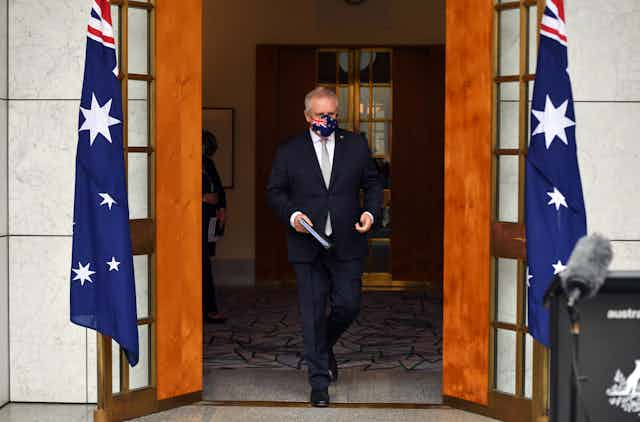National Cabinet met on Friday after a week of intensifying debate about the vaccination thresholds in the national plan for reopening the nation.
While expectations for the meeting were high, there was no showdown — at least as far as we know.
The current plan is vague, with words such as “may occur” and only subject to “in principle” agreement.
And the Doherty Institute modelling, which underpins the plan, acts as a fig leaf for the Commonwealth government to hide behind. So the plan has survived to live another day.
Deferring the day of reckoning has papered over the cracks. National Cabinet is holding tight for another week and awaiting further modelling.
A decision to hold tight is likely a compromise between the three factions in the virtual meeting room. But it leaves many questions unanswered.
We have three factions
1. Commonwealth and NSW
In one faction, you have the Commonwealth and New South Wales, both committed to easing restrictions according to the vaccination thresholds set out in the Doherty report: 70% and 80% of the population aged 16 and over.
Prime Minister Scott Morrison probably wanted to hold firm. After repeated failures to hit his vaccine rollout targets, he cannot afford another change in the plan.
At the same time, NSW Premier Gladys Berejiklian has probably recognised she has lost the fight to control COVID in her state and wants political cover to claim victory. She has already announced the easing of some minor restrictions for fully vaccinated people.
2. Other states handling NSW leaks
In the second faction, you have states such as Queensland and Victoria affected by leaks of COVID cases from NSW.
These states would have wanted the modelling to reassure them their health systems would not be overwhelmed if they started to ease strong public health measures at low vaccination thresholds.
3. COVID-zero states
The third faction comprises the COVID-zero states, such as Western Australia, which would be concerned about any heightened risk of COVID leakage from other states.
These states only see downsides from easing restrictions too early, when not enough people are vaccinated. They do not want to throw away the benefits of their hard-won COVID-zero status.
How to broker peace?
To reconcile these conflicting positions, the leaders found peace in process: they decided to seek more information.
They agreed to establish a cross-jurisdictional working group, led by the heads of health departments, to investigate health and hospital system capacity and workforce needs in the next phases of the national plan.
This work will draw on the Doherty modelling, which shows many deaths will occur months after lockdowns end.
The group is due to report back by next week, presumably taking into account rapid advances in our understanding of how Delta might impact our health systems.
The other states will not want to replicate the makeshift responses NSW was forced into — such as triage tents to assess patients — because of escalating hospital admissions.
This process may provide a way out for the Commonwealth. At the moment, states are highlighting the impacts of the Commonwealth’s failures on slow vaccination rollouts. But they could be brought around by a big-enough payment to compensate for the increased pressure reopening could put on their hospital systems.
As former Prime Minister Paul Keating said, “never get between a premier and a bucket of money”.
States will also need more Pfizer doses. At the moment, the lion’s share of the available Pfizer doses is going to NSW, leaving GPs in other states — especially Victoria — scrambling to find doses to meet demand.
Although these side-deals will not mean the states come out ahead, at least, financially, they will not be so far in the red.
How about the Doherty modelling?
As the National Cabinet’s behind-the-scenes negotiations were going on, the Doherty Institute reconfirmed its recommendation of the 70% and 80% (adult population) vaccination thresholds. It continues to undertake further modelling, including specification of public health measures in areas of low vaccination coverage.
While the thresholds may not have changed, further modelling is yet to show how Australia’s rapidly rising COVID-19 case numbers impact the phasing, and the substance, of the plan.
For instance, specific policy measures, such as exempting vaccinated people from restrictions, must be incorporated into the modelling, since vaccinated people can still spread the virus.
What privileges are extended to fully vaccinated people — holders of a validated vaccine passport — will be one of the next big challenges for the states, both politically and in terms of implementation and monitoring.
How does vaccinating 12 to 15-year-olds fit in?
National Cabinet’s meeting took place the same day the Australian Technical Advisory Group on Immunisation (ATAGI) recommended vaccination for 12 to 15-year-olds, to begin on September 13.
But there were no updates to the national plan to include this age group as part of the total population vaccinated. The plan’s targets are still expressed as a proportion of the population aged 16 and over, rather than of the population soon eligible to be vaccinated, those aged 12 and over.
Read more: Should we vaccinate children against COVID-19? We asked 5 experts
This means 12 to 15-year-olds are completely missing from the plan. It makes no sense for the nation to track progress towards vaccination targets without including this group.
Any plan to ease restrictions must also consider the impact on children and their education, especially for those under 12, who are not expected to be vaccinated this year.
What next?
While National Cabinet might be holding tight, there is still much work to be done to fill the many gaps in the current plan. We still need a robust national plan all states can sign up to, without hedging or caveats.

